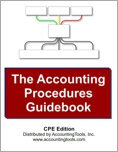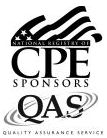Accounting Procedures Guidebook (CPE Course)
CPE Credit: 11 hours
Course Type: Downloaded PDF materials with online test
Price (with PDF Textbook): $75

Course Description
The typical business needs a system of policies and procedures in order to reduce errors, minimize fraud, and maintain tight control over its operations. The Accounting Procedures Guidebook
contains the detailed procedures and forms needed for every accounting system, from accounts payable to treasury, as well as for such operational areas as order entry, shipping, purchasing, and receiving. Procedures are separately stated for manual and computerized accounting systems. The course also addresses how to create and enforce procedures, as well as when to update them. In short, this course provides the baseline policy and procedure information needed to enhance the operations of any business.
Author:Steven Bragg
Course Number: AC1094
Table of Contents
Chapter 1. Overview of Accounting Procedures
Chapter 2. Order Entry Procedures
Chapter 3. Credit Procedures
Chapter 4. Shipping Procedures
Chapter 5. Customer Billing Procedures
Chapter 6. Collection Procedures
Chapter 7. Cash Receipts Procedures
Chapter 8. Purchasing Procedures
Chapter 9. Procurement Card Procedures
Chapter 10. Expense Report Procedures
Chapter 11. Petty Cash Procedures
Chapter 12. Receiving Procedures
Chapter 13. Accounts Payable Procedures
Chapter 14. Inventory Procedures
Chapter 15. Payroll Procedures
Chapter 16. Fixed Asset Procedures
Chapter 17. Treasury Procedures
Chapter 18. Closing the Books Procedures
Learning Objectives
-
Specify the situations in which procedures should or should not be employed, and the best procedure format to use. Also note the constituencies most interested in the development of procedures.
-
Specify the uses of order forms and return merchandise authorizations, and the application of verification techniques in the order entry process flow.
-
Identify the clauses and documents used in a credit review, as well as the triggering events for credit changes.
-
Specify the documents required in the shipping process flow.
-
Specify the flow of documents required to produce a customer invoice.
-
Specify the uses to which a credit memo can be put, and the positions involved in the collection process.
-
Identify the steps in the cash receipts process flow.
-
State the authorizing documents used to order goods and services, as well as the steps in the purchasing process.
-
Specify the control points in the analysis and processing of procurement card statements.
-
Identify allowable items to include in an expense report and situations in which per diem payments are made.
-
Recognize the situations in which the petty cash amount should be altered, and actions to take if a variance is found.
-
Recognize the documents used to control the inflow of goods to a business, and the contents of inventory tags.
-
Specify the reasons for using three-way matching and the variations on this concept to improve the processing of payables, as well as the use of adjustment letters.
-
Identify the reasons for verifying count tags and the uses to which a cycle counting report can be put.
-
State the differences between a timesheet and timecard, and note the contents of an employee record. Also recognize the types of employee pay deductions.
-
Specify the reasons for using a capital request form, the steps required to dispose of a fixed asset, and whether to engage in a post installation review.
-
Identify how investable cash is calculated, the use of a cash concentration account, and when to distribute inter-company cash.
-
Identify the situations in which subsidiary ledgers are closed, when approvals are needed before financial statements can be issued, and the approval process for EDGARizing financial statements.
Level: Overview
Instructional Method: QAS Self-Study
NASBA Category: Accounting
Prerequisites: None
Advance Preparation: None
Latest Review Date:July 2022
Program Registration Requirements: Click on "Purchase Course" near the top of this page to pay for and access the course. You will then be able to download the course as a PDF file, then take an on-line examination, and then download a certificate of completion if you pass the examination.
Program Refund Policy: For more information regarding administrative policies concerning complaints, refunds, and other matters, see our policies page.

AccountingTools, Inc. is registered with the National Association of State Boards of Accountancy (NASBA) as a sponsor of continuing professional education on the National Registry of CPE Sponsors. State boards of accountancy have the final authority on the acceptance of individual courses for CPE credit. Complaints regarding registered sponsors may be submitted to the National Registry of CPE Sponsors through its website: www.nasbaregistry.org .
The NASBA sponsor identification number for Accountingtools, Inc. is 115881.

AccountingTools is an IRS Approved Continuing Education Provider. We are compliant with the requirements for continuing education providers (as described in sections 10.6 and 10.9 of the Department of Treasury’s Circular No. 230 and in other IRS guidance, forms, and instructions). Our IRS Approved Continuing Education Provider number is 72821.

